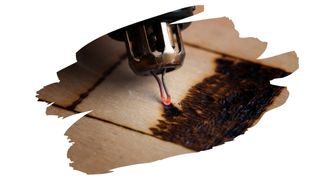The best type of wood for pyrography is one that’ll provide you with the perfect canvas. So when it comes to selecting pyrography timber, everything from grain texture to sap content, can all play a factor.
So, what exactly should you check for before you go purchasing some wood rounds? And how does Birch wood in particular stack up as a possible option?
Well, in this post, we cover the four key criteria you should look for in pyrography wood. You will also learn why Birch wood is fine for burning, but Baltic Birch Plywood is not.
And keep reading to discover which affordable north American hardwood is the go-to timber for wood burning beginners.

This post may contain affiliate links to products that we receive a commission for (at no additional cost to you). Learn more here.
What’s The Best Kind of Wood For Wood Burning Artwork?
When it comes to pyrography, you need to check if the wood you are using meets the following four criteria;
1). Light Color Grain
If wood has very dark grain, it can impact the clarity of your drawings. This is especially the case with very dark lumbers, such as Walnut, where it is hard for burn marks to contrast against that background.
So, lighter paler wood types are generally better for pyrography designs.
2). Unobtrusive Grain Texture
This one often gets overlooked, but it is as equally important to the clarity of your images.
Lumber with very distinct grain texture, (such as Red Oak), can make your images appear faded.
Related Post: Beginners Guide To Reducing Oak Grain Contrast (Explained)
3). Very Little Tree Sap/Pitch
There are certain types of wood, (such as Cedar or Pine), that have a lot of resinous tree sap in them. When you burn tree resins, not only do they create an excessive amount of smoke, but they also bubble over.
And it is that bubbling sap that’s the real problem. Why? Well, because that super-heated liquid sap will mess with the clarity of your artwork as well — especially any shading.
This is generally why you should skip overusing sap-saturated lumber for pyrography. Nevertheless, there is one caveat to all of this: Kiln dried wood.
Sap-rich wood types, that have been kiln dried, will have next-to-no tree resins left. So, you can use kiln-dried pine for wood burning.
You see, kiln-drying is a milling process that involves heating wood in a kiln-oven. Kiln-drying speeds up the seasoning process of wood, drying freshly cut wood in a fraction of the time.
However, that kiln not only evaporates the moisture contained in wood, but it’ll also evaporate tree sap.
4). No Toxic Chemicals Or Poisonous Compounds
Certain tree species contain compounds so toxic that you cannot risk burning them at all. These poisonous trees, (such as the Yew tree), should be crossed right off your list of pyrography woods.
On top of that, other wood types often come saturated with chemicals in them.
For example, Plywood and MDF are two wood composite materials that contain formaldehyde-based glues. So, needless to say, burning these materials should be avoided too.
Related Post: Is MDF Good For Pyrography?
OK. So What Is The Best Type Of Wood For Pyrography?
The best — and most affordable — wood for pyrography is Basswood. This North American hardwood has pale uniform grain that will contrast fantastically against burn lines.
What’s more, this lumber does not contain toxic compounds, or contain much in the way of resinous sap. Which is why Basswood is perfect for beginner pyrography artists looking to practice the fine techniques of this art-form.
You can find out more about Basswood (and where you can buy Bass rounds for wood burning) by checking out our post here: Is Basswood A Good Wood For Pyrography?
And What About Birch Wood? Is It Good For Pyrography Too?
Absolutely, it is. In fact, it shares many similar characteristics with Basswood.
Birch is another North America Hardwood that is both cheap and easily accessible.
It’s straight, (albeit sometimes wavy) fine grain won’t get in the way of the clarity of your art. And it is not a poisonous tree species, (or full of sap), so it is what we would call a ‘clean’ burning wood.
So, if you can get your hands on some natural solid Birch wood rounds, then feel free to use it for wood burning.
But What About Baltic Birch Plywood? Is It Any Good For Pyrography?
Well, Baltic Birch plywood — like most types of plywood — is not safe for wood burning. That is because this manufactured wood contains chemical adhesives. And the adhesives used in your typical standard sheet of Baltic Birch plywood often contains formaldehyde.
Still, there are certain specialized formaldehyde-free plywood types that you can purchase. But they are very expensive and not all that easy to access either.
Basically, the plywood you get from your local supplier, is likely to be the kind to contain formaldehyde-based glues.
You can learn more about this by checking out our post here: Is Plywood Really A Safe Wood For Pyrography?
To Wrap Up, Here Are The 3 Key Takeaways From This Post…
- 1). Wood types that have light colored uniform grain provide the perfect canvas for pyrography artwork.
- 2). Always avoid wood burning any kind of lumber that may contain toxic chemicals or poisonous compounds.
- 3). Natural solid Birch wood is ideal for pyrography. However, Baltic Birch plywood is unsuitable for wood burning. That’s because Baltic Birch plywood is a manufactured wood composite material that contains formaldehyde-based chemical glues.



